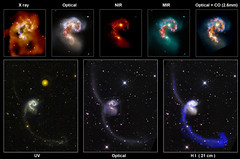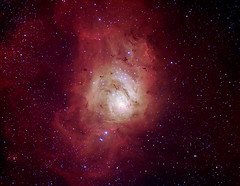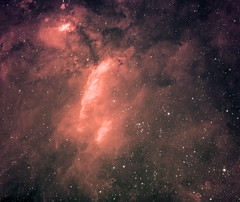In the last few days I’ve already answered some few emails and questions in social media about the Super Blood Blue Moon happening on the night from 31st January to 1st February 2018. What is this? Is this really important?
Short answer: No, it is not! This is just a lunar eclipse. The rest is hype to sell the story.

Visions of a Total Lunar Eclipse within clouds – 8 October 2014 – Sydney. More information and high resolution images in my Flickr. Credit: Ángel R. López-Sánchez.
Long answer: Let me use an email I wrote yesterday replying the questions asked by a journalist about this astronomical event.
1. Can you please define “super moon” “blood moon” and “blue” moon as they occur individually?
—> Supermoon: this is a term that many astronomers (me included) don’t like, as it was introduced by an astrologer (not an astronomer) but it is now very popular. It is just the moment the full moon is happening near the perigee (the Moon in its closest point to Earth). But, that is the important thing, the difference in size of a “supermoon” with respect an average moon is that a supermoon is ~5-6% larger than the average moon. That is almost nothing!!! Many people are confused with the “14% difference” between the supermoon and the micromoon (when the moon is near the apogee, the farthest point to the Earth).
I insist: it is VERY difficult for our naked eye to distinguish a supermoon from an “average” moon.
You can read a lot about this in the post I wrote two years ago and also in the second episode entitled “Blueberry Moon” of the new science podcast “The Skyentists” produced by Kirsten Banks and me.
—> Blood moon: If we astronomers don’t like the term “supermoon”, we really hate the name of “blood moon”. This is just a lunar eclipse!!
—> Blue moon: the now “standard” definition of a blue moon is when a second full moon is happening within the same calendar month. That is, it was full moon on Jan 2nd, the second full moon this month in Jan 31st is a blue moon.
HOWEVER, strictly talking THIS IS NOT TRUE FOR EASTERN AUSTRALIA (NSW, Tasmania, Victoria) and New Zealand, as the moment of the full moon is actually at 00:26am Feb 1st (Sydney/Melbourne time). It is true for Queensland (at 11:26pm Jan 31st), Alice Spring (at 10:56pm Jan 31st) and Perth (9:56pm Jan 31st).
In any case, the ONLY IMPORTANT real astronomical event is that this is a lunar eclipse (the rest is added to create some hype).
You can get plenty of information about the lunar eclipse in this webpage in timeanddate.com and also in this PDF file from NASA Lunar Eclipses.

All the important information for the lunar eclipse happening on the 31st Jan 2018. Credit: F. Espenak / NASA. Here the PDF file.
Australian astronomers have also written about this lunar eclipse. I recommend to have a look to this nice article published by Tanya Hill in The Conversation and also this article by Alan Duffy in Australia’s Science Channel
2. Is this the first time a super blue blood moon has occurred in 150 years?
Probably not, I don’t know, we actually don’t care about this much… It is just a lunar eclipse!!!!
3. How significant is this lunar event?
As I said, it is just a lunar eclipse. That is the point. The rest is added.
4. We are in north-west Victoria. What can people expect to see?
It does not matter where you are in Australia (or in the world, as long as it is night) to see this event. The only differences will be the local weather conditions… if the weather is good, you’ll see a very nice lunar eclipse. It is a perfect opportunity to enjoy the sky!!
5. Are there any tips to getting the best view of the eclipse, or what would be the best times to see it?
The best moment to see the eclipse is when the moon is completely covered by the Earth’s shadow. This happens between 11:52pm and 1:08pm, with the maximum eclipse at 12:30am. You’ll see a red-orange moon in the sky, pretty spectacular.
Addendum 31st Jan: I’ve been using the hashtag #itisjustalunareclipse in social media to say that, at the end… it is just a lunar eclipse!
References:
– 31 January 2018 — Total Lunar Eclipse in http://www.timeandate.com
– PDF file with all info of the lunar eclipse from NASA Lunar Eclipses.
– Supermoons, post published in this blog, 11 Nov 2016
– A blue blood supermoon is coming, by Alan Duffy in Australia’s Science Channel, 24 Jan 2018
– The next Full Moon brings a lunar eclipse, but is it a Super Blood Blue Moon as well? That depends…, Tanya Hill in The Conversation, 29 Jan 2018.
– A beginner’s guide to the Moon, Ian Musgrave and Genelle Weule in ABC News, 31 Jan 2018.
– The “Trifecta” Lunar Eclipse on January 31st, great article by Kelly Beatty in Sky & Telescope, 29 Jan 2018.










